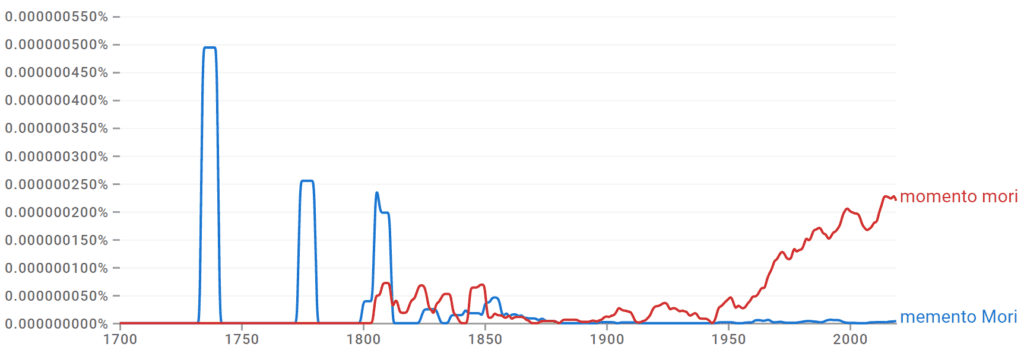Various cultures throughout history often have common denominators in relation to mortality and the passage of time. The idea of a memento mori, or symbolism of death, spans centuries, cultures, and even religious beliefs as an archetype of sorts to remind people of their inevitable demise.
Using these types of terms in your own speech, writing, and even art highlights a deeper message to your audience and truly levels up your communication skills. Let’s learn about this term, its history, and how you can use it.
What Does Memento Mori Mean?

Memento mori is a term used to describe an object or image that literally represents the phrase, “remember you must die.”
A memento mori is something that serves as a reminder of mortality. They tend to be ominous or frightening items; for example, skulls and representations of skulls have traditionally served as memento mori.
But the term can also denote less ominous things that remind one of their approach towards the end of life, such as a novel depicting the passage of time, a life insurance policy, or a seniors’ discount at the movie theater.
As a noun, memento mori is both singular and plural, though a few scattered instances of the plural memento moris are easily found. Like most long-established loan phrases in English, memento mori is usually unitalicized in modern use.
For example:
- For some cultures, all photographs are memento mori and symbolize participation in another’s inevitable mortality.
- Just because you know you will eventually die doesn’t mean you need to view everything that crosses your path as a memento mori.
- The parade included the horsemen, dressed in black and wearing the death head upon their breast…a living memento mori to those watching.
The term is also occasionally used in its original English sense as a verb phrase meaning, essentially, “remember death.”
For example:
- “Just remember,” she said, “Memento mori. Enjoy each moment you are blessed to experience.”
Is It Memento Mori or Momento Mori?

Is it memento mori or momento mori? The term is derived directly from Latin (more on that below) and is spelled memento mori. However, in true English fashion, words are often misconstrued in their spelling to reflect a more phonetic pronunciation.
Unfortunately, memento mori has fallen victim to this ignorance, and many people spell the term as momento mori due to their own mispronunciation of the foreign word.
The correct spelling is memento mori and should be used as such, no matter how many people get it wrong.
Memento Mori Origins
The idea behind memento mori is ancient, with evidence of the symbolic use of objects and images representing the reminder of death spanning back to the ancient Egyptians.
Remembering death is highlighted in much of Egyptian culture. Everything from worshiping the Egyptian god of death, Anubis, to the mounds, tombs, gigantic pyramids, and complex mummification and burial processes were all symbols created to serve as a reminder of death and the inevitable afterlife they believed in.
The term memento mori is Latin in origin. The Roman practice of using a slave to stand beside victorious military leaders to whisper, “Respice post te. Hominem te esse memento. Memento mori! (Look behind. Remember thou art mortal. Remember you must die)” is believed to have led to the actual iconography and creation of objects that served as physical memento mori.
It entered English in the 16th century and immediately gained its modern sense. Shakespeare, for one, used it in his 1598 play Henry IV, Part 1:
Bardolph: Why, Sir John, my face does you no harm.
Falstaff: No, I’ll be sworn; I make as good use of it as many
a man doth of a Death’s-head or a memento mori: I
never see thy face but I think upon hell-fire and
Dives that lived in purple; for there he is in his
robes, burning, burning.
Let’s Review
A memento mori is an object or symbolic image used to remind people of their inevitable death. It is an ancient practice that spans centuries, cultures, and religions and is often tied to iconography and burial practices to remind the living of the passage of time.
In its modern use, they aren’t always depicted as something ominous but may be depicted using events such as buying a burial plot, updating a life insurance policy, or moving into a senior living community.

Comments are closed.